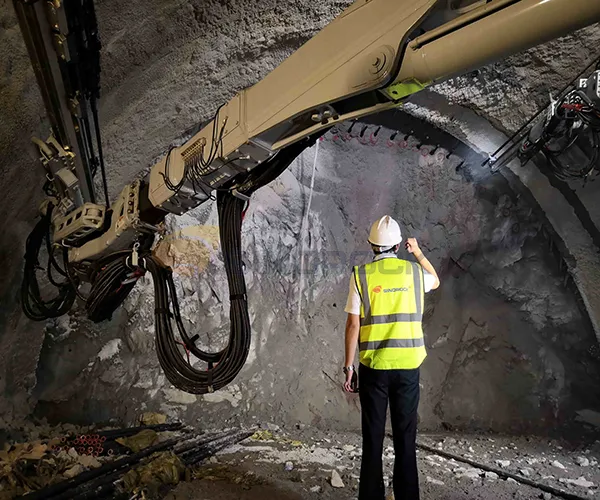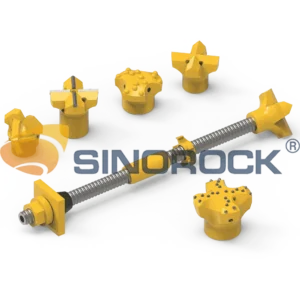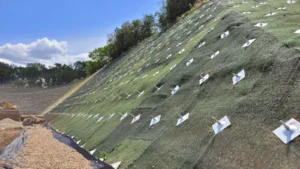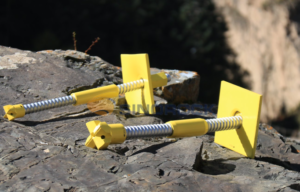Introduction
The construction of tunnels in geologically challenging conditions, especially in soft rock formations, presents significant engineering challenges. One of the primary issues is the large deformation of tunnel surrounding rocks, which can reach up to tens of centimeters. This substantial deformation causes the development and thickening of a plastic ring around the tunnel, exerting immense pressure on the supporting structures. Consequently, this can lead to the failure of these structures and the instability of the surrounding rock.
In response to these challenges, the soil nailing system has emerged as an innovative and effective solution for stabilizing tunnels in soft rock environments.
Understanding the Mechanics of Tunnel Deformation
Causes of Large Deformation in Tunnels
Large deformation in tunnels, particularly in soft rock formations, is primarily driven by the geological and geomechanical properties of the rock mass. Key factors include:
- Weakness and Fractures: Soft rocks often contain numerous fractures and weak planes, which reduce their overall strength and stability.
- High In-Situ Stress: In areas with high in-situ stress, the rock surrounding the tunnel is subjected to significant forces, leading to deformation.
- Plasticity and Creep: Soft rocks exhibit plastic behavior, meaning they can undergo significant deformation without immediate failure. Over time, this can lead to creep, further exacerbating deformation.
Impact on Tunnel Stability
The deformation of tunnel surrounding rocks has several detrimental effects on tunnel stability:
- Pressure on Support Structures: As the plastic ring around the tunnel thickens, it exerts immense pressure on the support structures, leading to potential failure.
- Instability of Surrounding Rock: The deformation can cause instability in the surrounding rock mass, increasing the risk of collapse.
- Increased Maintenance and Repair Costs: The need for frequent repairs and reinforcements to counteract deformation increases overall project costs and time.
The Role of Soil Nailing Systems
Basic Principles
Soil nailing involves the insertion of closely spaced steel bars (nails) into the ground to reinforce and stabilize the soil or rock mass. In the context of tunnel construction, soil nailing systems provide additional support to the tunnel walls, mitigating deformation and enhancing stability.
Mechanism of Action
The soil nailing system functions through several mechanisms:
- Tensile Reinforcement: The nails act in tension, counteracting the forces that cause deformation in the surrounding rock.
- Shear Resistance: By penetrating through weak planes and fractures, the nails increase the shear resistance of the rock mass.
- Arching Effect: The interaction between the soil nails and the rock mass creates an arching effect, distributing the loads more evenly and reducing stress concentrations.
Advantages in Large Deformation Environments
Soil nailing systems offer several advantages in environments prone to large deformations:
- Adaptability to Complex Geology: Soil nailing can be adapted to various geological conditions, making it suitable for tunnels in soft rock and weak fracture zones.
- Reduced Displacement: The system helps control and reduce the displacement of surrounding rock, maintaining tunnel stability.
- Enhanced Load Distribution: The formation of a “rock arch” and “pocket” within the rock mass improves load distribution and reduces frame load.
Application of Soil Nailing Systems in Tunnel Support
Design Considerations
The design of a soil nailing system for tunnel support involves several key considerations:
- Geological Survey: A comprehensive geological survey is essential to understand the properties and behavior of the rock mass.
- Nail Spacing and Length: The spacing and length of the soil nails must be optimized based on the geological conditions and the expected loads.
- Installation Method: The method of installation, including the drilling and grouting process, must ensure that the nails are securely anchored within the rock mass.

Installation Process
The installation of a soil nailing system in a tunnel involves several steps:
- Drilling Holes: Holes are drilled into the tunnel walls at predetermined intervals and angles.
- Inserting Nails: Steel bars are inserted into the holes, extending into the surrounding rock mass.
- Grouting: The nails are grouted in place to ensure a firm bond with the rock.
- Reinforcing Surface: A reinforcing surface layer, such as shotcrete, is applied to the tunnel walls to enhance stability.
Numerous case studies have demonstrated the effectiveness of soil nailing systems in tunnel support. For example:
- Tunnel in Soft Rock Formation: In a tunnel project through a soft rock formation, soil nailing was used to control deformation and prevent collapse. The system successfully stabilized the tunnel, allowing for safe and efficient construction.
- Weak Fracture Zone: In a tunnel passing through a weak fracture zone, conventional support methods proved inadequate. The implementation of a soil nailing system provided the necessary reinforcement, reducing deformation and enhancing stability.
Benefits and Challenges of Soil Nailing Systems
Benefits
The use of soil nailing systems in tunnel support offers several significant benefits:
- Increased Stability: Soil nailing enhances the stability of tunnels in soft rock and complex geological conditions.
- Cost-Effectiveness: By reducing the need for frequent repairs and reinforcements, soil nailing systems can lower overall project costs.
- Adaptability: The technique can be adapted to various geological conditions, making it a versatile solution for tunnel support.
Challenges
Despite its advantages, the implementation of soil nailing systems also presents several challenges:
- Design Complexity: The design of an effective soil nailing system requires a thorough understanding of the geological conditions and careful planning.
- Installation Difficulties: The installation process can be complex and time-consuming, requiring specialized equipment and expertise.
- Maintenance: Regular inspection and maintenance are necessary to ensure the long-term effectiveness of the soil nailing system.
Conclusion
The application of soil nailing systems in the support of tunnels subject to large deformations presents a promising solution to some of the most challenging aspects of tunnel construction in soft rock formations. By reinforcing the surrounding rock and reducing deformation, soil nailing systems enhance the stability and integrity of tunnels, ensuring safer and more efficient construction.
As tunnel projects continue to advance into increasingly complex and geologically challenging environments, the adoption of soil nailing systems is likely to grow. Engineers and construction professionals must continue to innovate and refine these systems, leveraging their benefits while addressing the associated challenges to achieve successful and sustainable tunnel construction.





